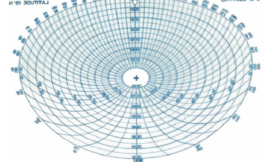There are two types of errors on sextants: – Adjustable and Non- adjustable errors.
a) Adjustable errors
Error of perpendicularity: The index glass must be
perpendicular to the plane of the instrument. It can be
checked by moving the index arm to almost near the
middle of the sextant arc. Hold the instrument
horizontally such that the index mirror is towards the
observer. Look into the index mirror to see if the reflected image of the arc is in line with the true graduated arc itself. If these are not in perfect alignment, then the error of perpendicularity exists. This error can be corrected by means of the first adjustment screw which is on the back of the Index mirror – (rotate the screw such that the reflected image and the arc itself are in line).
Side error – This error is caused by the horizon glass
not being perpendicular to the plane of the sextant. To
check for this error during day – set the index bar at
zero and observe the horizon through the telescope,
while holding the sextant in a horizontal position. If the true horizon and its reflection on the mirror half of the horizon glass appears in alignment, then no side error is present. If not then side error exists. At night, observe a star through the telescope, keeping the sextant in a vertical position – if the true image and the reflected image are displaced horizontally then side error is present. This error can be corrected by adjusting the second adjustment screw which is on the top and at the back of the horizon glass.
Error of collimation: This is due to the axis of the telescope not being parallel to the plane of the instrument. This error is generally present only in the old sextants that were provided with an adjustable telescope collar. This error could be corrected in these instruments by means of collimating screws provided on the telescope’s collar. In modern sextants – the telescope comes attached to the body of the sextant in such a manner that it cannot tilt and so error of collimation is eliminated.
Index error: After correction of the three errors mentioned above, check if the index glass and the horizon glass are parallel to each other when the index bar is set to zero. If not then INDEX ERROR exists. The index error can be found by various methods:
During the day – Set the index bar at zero and keeping the sextant vertical, observe the horizon through the telescope. If the true horizon and the reflected image appear in the same line then there is no index error. If they are not in the same line then adjust the micrometer on the index bar till they are on the same line. This will be the index error which can be “off the arc” or “on the arc” depending whether the reading is below zero or above zero on the scale.
During the night – The index error can be found by observing a star through the telescope with the index bar clamped at zero. If there is any vertical displacement between the star and its reflection, then index error exists and the amount can be found by adjusting the micrometer.
The index error can be eliminated by adjusting the third adjustment screw which is located below the second adjustment screw and towards the side, at the back of the horizon glass.
NOTE: When the second and third adjustments being carried out on the horizon glass, one adjustment may affect the other. It is therefore advisable after adjusting one, to check for the other. Any residual error will have to be applied as index error to all sextant observation readings. Generally if the index error is not large (less than 3.0′) it is left uncorrected and allowed for when observing altitudes.
b) Non adjustable errors
There are errors which cannot be corrected on board.
These include:-
1. Prismatic error
2. Centering error
3. Graduation error
To correct above errors, the sextant would have to be sent ashore to the manufacturers.




